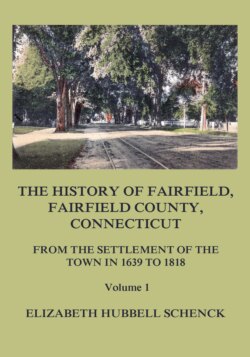Читать книгу The History of Fairfield, Fairfield County, Connecticut: From the Settlement of the Town in 1639 to 1818: Volume 1 - Elizabeth Hubbell Schenck - Страница 6
На сайте Литреса книга снята с продажи.
ОглавлениеFootnotes
1 A more pleasing incident than this occurred soon after their arrival at Saybrook. A Dutch vessel which had been sent by Governor Stuyvesant to rescue two young English girls, captured at Weathersfield by the Pequots, cast anchor under the guns of the fort. Upon learning that they were furnished with articles for trading with the Pequots, the garrison ordered them not to leave, lest the metal articles on board might be purchased and manufactured into arrow heads by the savages. After a parley, the captain was allowed to proceed on his mission. Upon entering the Thames, he dispatched a messenger to Sassacus offering a ransom for the two young girls, but the haughty chief refused to give them up. The Dutch captain then invited some of the principal Pequots on board his vessel, made them prisoners, and sent a message to Sassacus, that unless he exchanged seven of the prisoners for the two girls, he would throw them all into the sea. Sassacus at first laughed at the threat, but through the influence of the wife of Mononotto was induced to make the exchange, to the great joy of the young girls and their friends. Gardiner says in his history of the Pequot War, that he paid £10 to ransom the two girls.
2 Wequash was a Neantic Sagamore, who revolted from the Pequots. He was greatly affected by the remarkable victory of the English over them. " So great was his conviction of the power & glory of the God of the Englishman, that he went about the colony of Connecticut after the war, with bitter lamentations that he did not know Jesus Christ, until the good people instructed him, when he became an earnest convert to Christianity. " He was supposed to have been poisoned by those Indians, who hated him for having embraced Christianity. — Mather's Magnalia. '
3 Dr. Thomas Pell, a gentleman of good family from London, was sent from the fort at Say-' brook, as surgeon of the expedition. He afterward settled at New Haven, from whence he removed to Fairfield, and afterwards to Westchester, N. Y., where he purchased of the natives a large tract of land, which was given the name of Pellham. — Styles' History of Windsor, p. 38.
Mrs. Martha J. Lamb's Hist, of New York I. 171, 257, 381. Bolton's Hist, of Westchester. Dr. Pell's will was probated at Fairfield, and some reliable documents in regard to his nephew John Pell of London, are on file there.
4 Cotton Mather states " that at one time some hundreds of them were seized by Captain Stoughton with little opposition, who sending away the females & children as captives, put the men on board a vessel of one Skipper Gallop, which proved a Charons ferry-boat unto them, for it was found the quickest way to feed the fishes with 'em." Magnalia, I., B. VII., 483. Hubbard's Indian Wars, p. 35.
